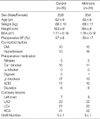1. Grundeman PF, Borst C, van Herwaarden JA, Mansvelt Beck HJ, Jansen EW. Hemodynamic changes during displacement of the beating heart by the Utrecht Octopus method. Ann Thorac Surg. 1997. 63:S88–S92.
2. Grundeman PF, Borst C, Verlaan CW, Meijburg H, Moues CM, Jansen EW. Exposure of circumflex branches in the tilted, beating porcine heart: echocardiographic evidence of right ventricular deformation and the effect of right or left heart bypass. J Thorac Cardiovasc Surg. 1999. 118:316–323.
3. Nierich AP, Diephuis J, Jansen EW, Borst C, Knape JT. Heart displacement during off-pump CABG: how well is it tolerated? Ann Thorac Surg. 2000. 70:466–472.

4. Porat E, Sharony R, Ivry S, Ozaki S, Meyns BP, Flameng WJ, Uretzky G. Hemodynamic changes and right heart support during vertical displacement of the beating heart. Ann Thorac Surg. 2000. 69:1188–1191.

5. Mathison M, Edgerton JR, Horswell JL, Akin JJ, Mack MJ. Analysis of hemodynamic changes during beating heart surgical procedures. Ann Thorac Surg. 2000. 70:1355–1360.

6. Kikura M, Levy JH, Michelsen LG, Shanewise JS, Bailey JM, Sadel SM, Szlam F. The effect of milrinone on hemodynamics and left ventricular function after emergence from cardiopulmonary bypass. Anesth Analg. 1997. 85:16–22.

7. Monrad ES, Baim DS, Smith HS, Lanoue AS. Milrinone, dobutamine, and nitroprusside: comparative effects on hemodynamics and myocardial energetics in patients with severe congestive heart failure. Circulation. 1986. 73:III168–III174.
8. Chen EP, Bittner HB, Davis RD Jr, Van Trigt P 3rd. Milrinone improves pulmonary hemodynamics and right ventricular function in chronic pulmonary hypertension. Ann Thorac Surg. 1997. 63:814–821.

9. Kwak YL, Oh YJ, Shinn HK, Yoo KJ, Kim SH, Hong YW. Haemodynamic effects of a milrinone infusion without a bolus in patients undergoing off-pump coronary artery bypass graft surgery. Anaesthesia. 2004. 59:324–331.

10. Feigenbaum H. Echocardiography. 1993. 5th ed. Philadelphia: Lea & Febiger;195–198.
11. Skoyles JR, Sherry KM. Pharmacology, mechanisms of action and uses of selective phosphodiesterase inhibitors. Br J Anaesth. 1992. 68:293–302.

12. Maslow AD, Regan MM, Schwartz C, Bert A, Singh A. Inotropes improve right heart function in patients undergoing aortic valve replacement for aortic stenosis. Anesth Analg. 2004. 98:891–902.

13. Feneck RO. The European Milrinone Multicentre Trial Group. Intravenous milrinone following cardiac surgery: II. Influence of baseline hemodynamics and patient factors on therapeutic response. J Cardiothorac Vasc Anesth. 1992. 6:563–567.

14. Kwak YL, Oh YJ, Jung SM, Yoo KJ, Lee JH, Hong YW. Change in right ventricular function during off-pump coronary artery bypass graft surgery. Eur J Cardiothorac Surg. 2004. 25:572–577.

15. Burger W, Brinkies C, Illert S, Teupe C, Kneissl GD, Schrader R. Right ventricular function before and after percutaneous balloon mitral valvuloplasty. Int J Cardiol. 1997. 58:7–15.

16. He GW, Yang CO, Gately H, Furnary A, Swanson J, Ahmad A, Floten S, Wood J, Starr A. Potential greater than additive vasorelaxant actions of milrinone and nitroglycerin on human conduit arteries. Br J Clin Pharmacol. 1996. 41:101–107.

17. Burger W, Jockwig B, Rucker G, Kober G. Influence of right ventricular pre- and afterload on right ventricular ejection fraction and preload recruitable stroke work relation. Clin Physiol. 2001. 21:85–92.

18. Remme WJ, van Hoogenhuyze DC, Kruijssen HA, Pieper PG, Bruggeling WA. Preload-dependent hemodynamic effects of milrinone in moderate heart failure. Cardiology. 1992. 80:132–142.

19. Vincent JL, Thirion M, Brimioulle S, Lejeune P, Kahn RJ. Thermodilution measurement of right ventricular ejection fraction with a modified pulmonary artery catheter. Intensive Care Med. 1986. 12:33–38.

20. Urban P, Scheidegger D, Gabathuler J, Rutishauser W. Thermodilution determination of right ventricular volume and ejection fraction: a comparison with biplane angiography. Crit Care Med. 1987. 15:652–655.
21. Chassot PG, van der Linden P, Zaugg M, Mueller XM, Spahn DR. Off-pump coronary artery bypass surgery: physiology and anaesthetic management. Br J Anaesth. 2004. 92:400–413.
22. Baruch L, Patacsil P, Hameed A, Pina I, Loh E. Pharmacodynamic effects of milrinone with and without a bolus loading infusion. Am Heart J. 2001. 141:266–273.








 PDF
PDF ePub
ePub Citation
Citation Print
Print


 XML Download
XML Download